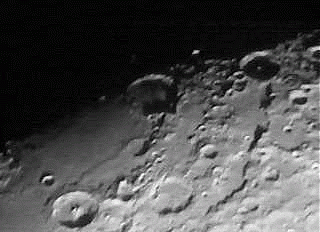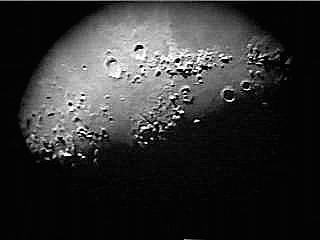Telescopic Only Objects...
Sinus Aestuum:
Date: July 21, 2003
Telescope: 4.5 Celestron
Eyepieces: 25mm Celestron, 10mm Celestron
Time: (no specific time listed. reports indicate early a.m.)
Comments: find a cold beauty in the Sinus Aestuum. The tiny craters of Bode and Pallas suit me well. In world? I am the Raven... Perched on the bust of Pallas. "Nevermore."
Lacus Mortis:
Date: April 26, 2004
Telescope: 45. Celestron
Eyepieces: 17mm Sirius Plossl, 12.3mm ED Epic
Seeing: 4 8/10
Time: 9:00-10:00 p.m. ESDT
Comments: South of the overlit Atlas and Hercules, Lacus Mortis isn't much more than and expanse of smooth, grey sands with an occassional tiny, bright pockmark.
Palus Putredinis:
Date: December 1, 2003
Telescope: 4.5 Celestron
Eyepieces: 25mm Celestron, 10mm Celestron
Time: (no specific time given. reports indicate early evening.)
Comments: Another such "coolie" is Paulus Putredinus down by Autolycus. Once upon a time, the Soviets sent a little guy named Lunik 2 to explore there and its' crash landing was observed and reported by European astronomers as a "strange black dot".
Promentorium Laplace:
February 11, 2003
Time: 7:15-8:00 pm EST
Seeing: 4 6/10
Scope: 4.5 Celestron
Eyepiece: 9mm Meade
Comments: It is no great secret that the Sinus Iridium in one of my favorite portions of the Moon, and Promentorium LaPlace has been an oft viewed object.
During this phase, LaPlace is bright and casts great shadow. The mountain top that comprises it is regular and flattened... like there is a plateau. During moments of perfect stabiity, an almost pinscher-like formation shows to the south extending into the floor of the Sinus Iridium. Just north of it, small craterlet D is a perfect ring.
Date: November 14, 2002
Telescope: 150mm Intes
Eyepiece: 17mm Sirius Plossl
Time: (no specific time given. reports indicate early p.m.)
Comments: Sinus Iridum is razor sharp. The terminator is right at the edge of the Juras Mountains, making Promentoriums LaPlace and Heraclides simply shine. Bianchini is perfect as always. I focus myself toward the Rukl atlas for some assistance in crater identification, and take great pride in identifying Maupertuis and Condamine as well. Continuing on my lunar tour I discover Bouguer and a crater on the edge called Focault. Focault? Laughing to myself, I hear an old tune playing in my head... "Dancin' In The Moonlight". It gives me a most genuine smile as I wonder what I would be like to waltz around "the Bay of Rainbows" with you...
Promentorium Heraclides:
February 11, 2003
Time: 7:15-8:00 pm EST
Seeing: 4 6/10
Scope: 4.5 Celestron
Eyepiece: 9mm Meade
Comments: This is the perfect time to view Promentorium Heraclides. It sits right on the edge of the terminator and the shadows of sunrise show details that otherwise might be missed.
Heraclides is a broken structure. There is a shallow, jagged depression that runs through the center of it, and a small craterlet named "A" toward it's eastern frontier. During moments of perfect stability, Promentorium Heraclides also shows some small singlular looking mountain peaks that break away from the main structure toward the Sinus Iridium.
Another very prominent feature of Heraclides is a long, soft rille that extends partially into the Sinus Iridium and gains in both power, strength and shadow as it snakes it's way into Mare Ibrium and into the small bright ring of C. Herchel. This same rille continues south, gaining in altitude and size and continues on to be known as Dorsum Heim.
A true beauty.
(Side Note: Apollo 17 landing area)

Promentorium LaPlace is the bright peak on the lower edge of Sinus Iridum and Promentorium Heraclides is opposite above and darker. Seperated by Mare Frigoris, Crater J. Herschel also appears at the bottom of the frame.
Promentorium Agarum:
February 5, 2003
Time: 7:50 - 8:30 pm EST
Seeing: 5.5 8/10
Scope: 4.5 Celestron Reflector
Eyepiece: 12.3mm Epic ED
Comments: Promentorium Agarum is a lovely, sharp peninsula that intudes on the eastern edge of Mare Crisium. It has a steep wall toward the west that appears much like a cliff. The northern edge, or point, is littered with small craterlets. A soft, white wash of a rille extended from the point to the north.
Montes Alpes:
Date: March 21, 2002
Telescope: 4.5 Celestron
Eyepiece: 25mm Celestron
Time: (no specific time given. reports indicate early evening.)
Comments: The Alpine Valley was what drew my attention the most. Sure. It's an oft repeated target, but that deep scar on Selene keeps me intrigued. (perhaps because we have it in common, eh?) The Apennine Mountains looked jagged and sharp... Each peak throwing itself into sharp relief. Mons Piton, Mons Blanc, Mons Pico, Mon Wolfe, Montes Alpes, Montes Spitzenberg.... All splendid. All fascinating...
Montes Apenninus:
Date: June 8, 2003
Telescope: 4.5 Celestron
Eyepiece: 25mm Celestron
Time: (no specific time given. report indicates early evening.)
Comments: There are times when I can be very simple minded... And I love this as well. Wanting nothing more than to just enjoy the beauty of the expanse of the Appennine Mountains. Desiring nothing more from the night than to look into the loveless eye of Plato and to follow the rilles to Archimedes. I want nothing more than to know that Goldschmidt is there... And that I have no need to pick it apart. It is thrill enough to see the singular peaks of Mons Piton and Pico... And the know the scar of the Alpine Valley looks much less harsh in this light. A feeling of sympatico...

The Caucasus and Apennine Mountains...
Mons Hadley, Mons Piton and Mons Pico:
Date: March 21, 2002
Telescope: 4.5 Celestron
Eyepieces: 25mm Celestron, 10mm Celestron
Time: (no specific time listed. reports indicate early evening.)
Mons Hadley, Piton, and Pico: Comments: The Apennine Mountains looked jagged and sharp... Each peak throwing itself into sharp relief. Mons Piton, Mons Blanc, Mons Pico, Mon Wolfe, Montes Alpes, Montes Spitzenberg.... All splendid. All fascinating...
Rupes Altai:
Date: July 15, 2002
Telescope: 4.5 Celestron
Eyepieces: 25mm Celestron, 10mm Celestron
Time: (no specific time given. reports indicate early evening.)
Comments: Don't tell me I Kant! Hehehheee... Beautiful, isn't it? The entire area around Theophilus, Cyrillius, and Catharina is alive tonight with tiny craters. The Altai Scarp, even though it only averages about a mile high presents itself most well. Tiny craters that will soon be lost to the light, like Tacitus, Zollner, Alfraganus and Hypatia... and the delicate Sabine, Ritter and Polybius. Adding just a bit more power makes exploring areas inside of Cyrillius turn into a fantasy-land of lunar landscape!

The Altai Scarp runs from the edge of Piccolomini at the top, through Catherina towards the bottom.
Rima Hyginus:
Date: November 30, 2003
Telescope: 4.5 Celestron
Eyepieces: 25mm Celestron, 10mm Celestron
Time: (no specific time listed. reports indicate early evening.)
Comments: Caught in Mare Vaporum, both the Ariadaeus Rille and Hyginus Rille show very well, but the "Horseshoe" looks very unusual at just this point in time. It's really not anything special... Just an unusual area caught in the lava flow that resembles a healed scar. There are a few nice features that show as well, like crater Boscovich and its' central wall... But I just like that eye-shaped area with the rille creasing through it.
Vallis Schroteri:
February 13, 2003
Time: 7:00-8:00 pm EST
Seeing: 8/10
Scope: 4.5 Celestron
Eyepiece: 9mm Meade
2X barlow
Comments: Even unfiltered, the ultra-bright Aristachus cannot eradicate Schroeter's Valley. Tonight it sits just at the edge of the terminator, allowing one of the finest views I've seen of it in a very long time. The Montes Agricola is also very well hightlighted, but perfectly straight compared to the long, snaking bright ribbon that is the Vallis Schroterii... This 2 to 5 mile wide and 125 mile long feature is well highlighted.
Now, let's see what it looks like at the eyepiece!!

Just rockin', isn't it?
Vallis Alpes:
Date: October 13, 2002
Telescope: 4.5 Celestron
Eyepieces: 25mm Celestron, 10mm Celestron
Time: (no specific time listed. reports indicate early evening.)
Comments: As you can see, the north just begged for exploration. The 110 mile long, and 1 to 13 mile wide scar of the Alpine Valley was simply so clean, I had to contain my excitement long enough to take a brief picture! Enough... Time to drop the power on it and just walk that terminator!

The Alpine Valley appears as a dark scar through the Montes Alpes in this frame.
Rupes Recta:
Date: June 18, 2002
Telescope: 4.5 Celestron
Eyepieces: 25mm Celestron, 10mm Celestron
Time: (no specific time given. reports indicate early evening.)
Comments: The "Straight Wall" simply dominated the lunar landscape tonight. As the steepest of slopes on the Moon, rising at a 41 degree angle it runs for 75 miles and reaches a height of 1200 feet. It is a fine place to be...

The "Straight Wall" appears as a fine white line roughly in the center of this frame.
|